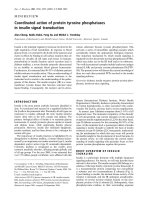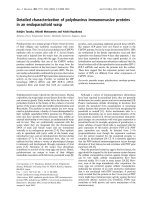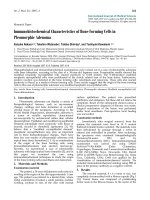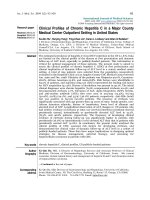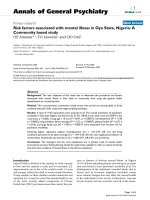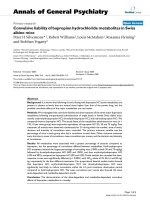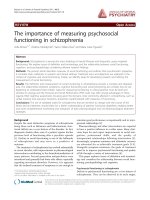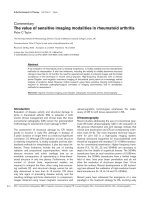Báo cáo y học: "Prognostic factors of 10-year radiographic outcome in early rheumatoid arthritis: a prospective study" ppt
Bạn đang xem bản rút gọn của tài liệu. Xem và tải ngay bản đầy đủ của tài liệu tại đây (171.59 KB, 9 trang )
Open Access
Available online />Page 1 of 9
(page number not for citation purposes)
Vol 10 No 5
Research article
Prognostic factors of 10-year radiographic outcome in early
rheumatoid arthritis: a prospective study
Natacha Courvoisier
1
, Maxime Dougados
2
, Alain Cantagrel
3
, Philippe Goupille
4
, Olivier Meyer
5
,
Jean Sibilia
6
, Jean Pierre Daures
7
and Bernard Combe
8
1
Service de Rhumatologie, Hôpital Saint Antoine, 184 rue du Faubourg Saint Antoine, Paris, 75012, France
2
Service de Rhumatologie B, Hôpital Cochin, 27 rue du Faubourg Saint Jacques, Paris, 75014, France
3
Service de Rhumatologie, Hôpital Larrey, 24 chemin de Pouvourville, Toulouse, 31059, France
4
Service de Rhumatologie, Hôpital Trousseau, avenue de la République, Tours, 37044, France
5
Service de Rhumatologie, Hôpital Bichat, 46 rue Henri Huchard, Paris, 75018, France
6
Service de Rhumatologie, Hôpital Hautepierre, 1 avenue Molière, Strasbourg, 67092, France
7
Institut Universitaire de Recherche Clinique, 641 avenue du Doyen Gaston Giraud, Montpellier, 34093, France
8
Service d'Immuno-Rhumatologie, Hôpital Lapeyronie, 371 avenue du Doyen Gaston Giraud, Montpellier, 34295, France
Corresponding author: Bernard Combe,
Received: 19 Feb 2008 Revisions requested: 31 Mar 2008 Revisions received: 18 Jul 2008 Accepted: 4 Sep 2008 Published: 4 Sep 2008
Arthritis Research & Therapy 2008, 10:R106 (doi:10.1186/ar2498)
This article is online at: />© 2008 Courvoisier et al.; licensee BioMed Central Ltd.
This is an open access article distributed under the terms of the Creative Commons Attribution License ( />),
which permits unrestricted use, distribution, and reproduction in any medium, provided the original work is properly cited.
Abstract
Introduction The objectives of this study were to determine the
predictive factors of long-term radiographic outcome of
rheumatoid arthritis (RA) and to describe the relationship
between joint damage and disability over the course of the
disease.
Methods A cohort of 191 patients with early RA referred from
primary care physicians were prospectively followed for 10
years. To determine the predictive factors of radiographic
outcome, univariate analysis of the relationship between
baseline values and outcome measures was undertaken using a
chi-squared or Fisher's exact test. Stepwise multiple logistic
regression was also performed to select independent
prognostic factors.
Results From data available for 112 patients, univariate analysis
revealed a total Sharp score at 10 years that was significantly
correlated with erythrocyte sedimentation rate (ESR), presence
and level of IgA rheumatoid factor, presence of an anti-
citrullinated protein antibody (ACPA), serum level of matrix
metalloproteinase-3 and radiographic score at baseline. Logistic
regression identified the baseline erosion score to be the most
important baseline parameter as an independent prognostic
factor of total radiographic score at 10 years (odds ratio = 5.64;
95% confidence interval = 1.78 to 17.86). After excluding
radiographic scores from the entry parameters, the presence of
ACPA and ESR were also predictive of the final total Sharp
score. The Health Assessment Questionnaire (HAQ) score was
strongly correlated with disease activity parameters, such as
disease activity score and pain, at baseline and at three, five and
10 years. No correlation was found between total radiographic
Sharp score and HAQ score throughout the study.
Conclusions In this prospective study, baseline radiographic
score, ESR and ACPA were the best predictive factors of 10-
year radiographic outcome in early RA. HAQ disability was
associated with disease activity throughout the 10-year follow-
up but not with joint damage. This discrepancy with previous
reports may be due in part to the early start of therapy with
disease-modifying anti-rheumatic drugs.
Introduction
Rheumatoid arthritis (RA) is a potentially severe but heteroge-
neous disease. It can vary from mild to severe and in some
cases can lead to severe joint damage and functional disabil-
ity. Predicting RA outcomes is fundamental for optimal clinical
management. Predictive factors of long-term outcome would
ACPA: anti-citrullinated protein antibody; CCP: cyclic citrullinated peptide; CI: confidence interval; CRP: C-reactive protein; DAS: disease activity
score; DMARD: disease-modifying antirheumatic drugs; ESR: erythrocyte sedimentation rate; HAQ-DI: Health Assessment Questionnaire Disease
Index; HLA: human leucocyte antigen; HSP90: heat-shock protein 90; IF: immunofluorescence; Ig: immunoglobulin; MCID: minimum clinically impor-
tant difference; MMP3: matrix metalloproteinase 3; OR: odds ratio; r: Pearson's correlation coefficient; RA: rheumatoid arthritis; RF: rheumatoid factor;
SD: standard deviation; SE: standard error; VAS: visual analog scale.
Arthritis Research & Therapy Vol 10 No 5 Courvoisier et al.
Page 2 of 9
(page number not for citation purposes)
help physicians determine the patients who will develop a
severe form of the disease and treat them with appropriate
aggressive therapy at an early stage. This ability is even more
important with the availability of new treatments that can
reduce or even stop the progression of RA. Radiographic
damage is frequently used as a major assessment criterion for
RA outcome. Numerous studies have identified possible initial
individual factors associated with worse radiographic out-
come, but there are many discrepancies between the studies
and few were long-term (or) and prospective.
Joint damage increases slowly over the course of RA, and dis-
ability, decreasing during the first years, worsens with disease
duration [1]. Disability in RA is influenced by parameters such
as age, sex, social and psychological factors, muscle strength
and co-morbidities. It is also associated with disease-related
factors such as disease activity and joint destruction. The links
between functional disability, joint damage and disease activ-
ity seem to vary with disease duration [2-4]. In early RA, func-
tional impairment is believed to be mostly due to inflammatory
processes as measured by disease activity [2,4-6]. In estab-
lished RA, disability may be due to joint damage [2-4]. Pro-
spective studies of the links between joint damage and
functional disability are scarce and discordant in part, so the
association between damage and disability remains uncertain.
Several assessment tools are available for measuring func-
tional capacity. The easiest and cheapest are self-adminis-
tered questionnaires. The most widely used instrument for
assessing functional capacity in RA is the Health Assessment
Questionnaire Disability Index (HAQ-DI) [7]. Joint damage is
commonly assessed with radiographic scores, such as the
Sharp score, modified by van der Heijde [8].
The main objective of our study was to determine the predic-
tive factors of long-term radiographic outcome in early RA. The
secondary objective was to describe the long-term outcome of
joint destruction and disability in RA and their interrelation over
the course of the disease.
Materials and methods
Patients
Between March 1993 and October 1994, all consecutive out-
patients fulfilling the American College of Rheumatology crite-
ria for RA for less than one year who had not been treated with
disease-modifying antirheumatic drugs (DMARD) were
referred to the study by primary care physicians from four
French centres, Montpellier, Paris-Cochin, Toulouse and
Tours. The patients had agreed to be enrolled in a 10-year fol-
low up study, also giving signed informed consent. After inclu-
sion, all patients were treated with DMARDs (methotrexate,
sulfasalazine or both) that could be modified during the study
according to efficacy and side effects. The study was
approved by the ethical review board in Montpellier.
Clinical assessment
The following data were collected by the same investigator for
each patient at baseline and at three, five and 10 years: sex,
age, disease duration (at baseline), pain on a visual analog
scale (VAS), duration of morning stiffness, number of tender
and swollen joints, disease activity score (DAS), presence or
absence of nodules, and extra-articular manifestations.
Biological assessment
Erythrocyte sedimentation rate (ESR) and C-reactive protein
(CRP) levels were measured at baseline and at each follow-up
visit in each centre. Measurements of the following were cen-
tralised in a single laboratory at baseline: immunoglobulin (Ig)
A and IgM rheumatoid factor (RF) (anti-human Fc IgG ELISA),
anti-keratin antibodies (indirect immunofluorescence [IF] on a
cryostat section of rat oesophagus), anti-perinuclear antibod-
ies (IF on buccal epithelial cells), anti-cyclic citrullinated pep-
tide (anti-CCP) antibodies (ELISA kit; Immunoscan RA mark 2,
Eurodiagnostica Arnhem, Netherlands), anti-nuclear antibod-
ies (IF on Hep2 cells), anti-heat-shock protein 90 (anti-
HSP90) antibodies (ELISA), YKL-40 (radioimmunoassay;
Chondrex Metra Biosystems, Mountain view, CA, USA) and
serum level of matrix metalloproteinase 3 (MMP 3) (ELISA) [9].
The patients who had positive results for anti-CCP, anti-keratin
or anti-perinuclar antibodies were considered as ACPA (anti-
citrullinated protein antibody) positive. Human leucocyte anti-
gen (HLA) DRB1 and DQB1 genotyping was performed as
previously described [10].
Functional assessment
Functional disability of each patient was assessed by the HAQ
at baseline and at three, five and 10 years [7]. This instrument
has been adapted and validated in French [11]. Functional sta-
tus of patients was scored on a continuous scale from 0 to 3.
Patients were classified as mildly disabled (score < 1), moder-
ately disabled (score 1 to 2) or severely disabled (score > 2)
[12].
Radiographic measurement
Patients underwent radiography of hands and feet in each
centre at baseline and at three, five and 10 years. Radiographs
were collated and evaluated blindly in chronological order
according to the Sharp score modified by van der Heijde [8].
For each patient, an erosion score, a joint-narrowing score and
a total radiographic score were noted. A single observer eval-
uated the radiographs at baseline and at 10 years. A second
evaluation was performed on a random sample of 30 pairs of
radiographs for validation. The intraclass correlation coeffi-
cient varied between 0.89 and 0.99. The radiographs taken at
three and five years were evaluated by two other observers,
who also performed a second evaluation on 30 pairs of radio-
graphs taken at these same times. The intraclass and interob-
server correlation coefficients were more than 0.85.
Available online />Page 3 of 9
(page number not for citation purposes)
Statistical methods
Statistical analysis was performed using SAS software, ver-
sion 8-1 (SAS, Gary, IN). Outcome variables were dichot-
omised into qualitative variables: higher or lower than the
median value for the total Sharp score at 10 years, and pres-
ence or absence of radiographic progression seen on radiog-
raphy. Radiographic progression was defined by a change in
the radiographic score greater than the 'minimum clinically
important difference' (MCID). The OMERACT determined this
MCID for the modified Sharp score to be five points [13].
Univariate analysis of the relation between all baseline values
and outcome measures involved the chi-squared test or
Fisher's exact test. Continuous variables were transformed
into categorical variables with the median value used as the
cut-off. A stepwise multiple logistic regression model was
used to determine relevant independent prognostic variables.
The prognostic variables included in the model were selected
from results of the univariate analysis. The entry level was set
at p = 0.10. Significant levels for changes over time in radio-
graphic and HAQ scores were determined by the Friedman
test. We used the MCID as determined by the OMERACT for
the modified Sharp score. For the HAQ score, we used the
MCID calculated by Kosinski of 0.24 points [14]. Comparative
tests were performed to search for possible links between the
variables studied over the time period: that is, between the
HAQ and radiographic scores, and between the HAQ score
and parameters of disease activity. We used the Wilcoxon test
because the variables did not follow a normal distribution.
Pearson's correlation coefficients were also calculated. The
significance level was set at 0.05 for the whole study.
Results
Demographic, clinical and biological features of the
patients
We enrolled 191 patients in the study, and 129 (67%) were
followed up for 10 years. Forty-six patients were lost to follow-
up, 11 died and five refused further follow-up. Radiographic
data were available for 117 patients at 10 years (61.2%). Both
HAQ score and radiographic data were available for 112
patients (58.6%).
Baseline characteristics of the 112 patients are shown in
Table 1. No significant difference was found between the
baseline characteristics of the 79 patients that were not avail-
able for the 10-year analysis and those of the 112 patients
who were. Ninety (80.3%) patients were women; the mean
(SD) age at diagnosis was 50.4 ± 12.6 years and the mean
disease duration was 3.9 ± 2.8 months. Eleven (9.8%)
patients presented with extra-articular manifestations. At base-
line, DAS was 4.0 ± 0.7, ESR was 37.6 ± 26.7 mm and CRP
level was 29.1 ± 39.8 mg/L. RF and anti-CCP antibodies were
positive for 78.6% and 57.9% of patients, respectively. Sev-
enty-eight (70.2%) patients had at least one RA-associated
HLA-DRB1 allele.
After inclusion, all patients received methotrexate, sulfasala-
zine or both. During the 10-year follow-up, patients received
DMARDs for an average of 7.9 ± 3.3 years (Table 2). Meth-
otrexate treatment was maintained for a mean length of 5.2 ±
3.2 years. Twenty-seven (24.1%) patients received therapy
with a biological agent; 25 (22.3%) received one or more intra-
articular corticosteroid or radionucleid injection. Twenty-six
(23.2%) patients underwent joint surgery related to RA (32
procedures): 12 procedures were conservative treatments
(synovectomy) and 20 were palliative (arthrodesis, arthro-
plasty or metatarsian resection). We could not get precise
data regarding the use of oral corticosteroids over the 10-year
period, because most of the patients received such drugs at
various times and dosages. Nevertheless 33% of the patients
who were evaluated after three years and 34.6% evaluated
after five years had received a low dose of prednisone (5 to 15
mg/day) [15,16].
HAQ disability
HAQ score decreased from 1.29 ± 0.71 at baseline to 0.53 ±
0.62 after three years, before a slow increase to 0.57 ± 0.62
and 0.75 ± 0.71 at five and 10 years, respectively, but never
reaching the initial level (Table 3). At an individual level, most
patients (80.4%) improved in functional score between the ini-
tial and final visits. A significant worsening (≥ MCID) was
observed for only 14.1%.
Table 1
Baseline characteristics of patients (n = 112) with both
radiographs and Health Assessment Questionnaire score
available at 10 years
Characteristic
Female 90 (80.3%)
Age (years) 50.4 ± 12.6
Disease duration (month) 3.9 ± 2.8
Pain on a VAS (mm) 54.8 ± 22.9
Morning stiffness (minutes) 90.1 ± 80.2
Swollen joints 8.9 ± 5.8
Ritchie index score 17.3 ± 8.5
DAS 4.0 ± 0.7
Extra-articular manifestations 11 (9.8%)
ESR (mm) 37.6 ± 26.7
CRP level (mg/L) 29.1 ± 39.8
IgA or IgM RF positivity 81 (78.6%)
Anti-CCP ab positivity 51 (57.9%)
HLA-DRB1*04 or 01 alleles 78 (70.2%)
Data are means ± standard deviation, unless otherwise indicated.
CCP, cyclic citrullinated peptide; CRP, C-reactive protein; DAS,
disease activity score; ESR, erythrocyte sedimentation rate; HLA,
human leucocyte antigen; RF, rheumatoid factor; VAS, visual
analogue scale.
Arthritis Research & Therapy Vol 10 No 5 Courvoisier et al.
Page 4 of 9
(page number not for citation purposes)
Radiographic outcome
Total radiographic Sharp score increased from 5.8 ± 9 at
baseline to 9.5 ± 14.9, 17.3 ± 22.4 and 35.4 ± 46.1 at three,
five and 10 years, respectively (Table 3). At baseline, 61
patients (54.4%) did not show any erosion compared with 19
patients (16.9%) at 10 years. Over the 10-year period, 69.6%
of patients showed a significant progression in total radio-
graphic score (≥ MCID). The average annual rate of increase
in radiographic score was 2.96 points/year: 1.3 points/year
between baseline and three years, 3.9 points/year between
three and five years, and 3.62 points/year between five and 10
years.
Predictive factors of radiographic outcome
In univariate analysis, the total radiographic Sharp score at 10
years was significantly correlated with the following baseline
parameters (Table 4): ESR, positivity for and level of IgA RF;
positivity for anti-perinuclear, anti-CCP and ACPA; serum level
of MMP3; and radiographic scores (erosion score, joint nar-
rowing score and total score). No significant correlation was
found with any demographic, clinical (including joint count) or
genetic data. The baseline parameters associated with ero-
sion score and joint-narrowing score were similar (data not
shown). Radiographic progression was significantly associ-
ated with age; positivity for and level of IgA RF; positivity for
and level of IgM RF; positivity for anti-perinuclear, anti-keratin,
anti-CCP and ACPA; serum level of MMP3; and radiographic
scores (erosion score, narrowing score and total score).
The most important baseline parameter identified by logistic
regression as an independent predictive factor of total radio-
graphic Sharp score at 10 years was erosion score (odds ratio
[OR] = 5.64; 95% confidence interval [CI] = 1.78 to 17.86)
(Table 5). After excluding radiographic scores from the entry
parameters, the presence of ACPA and ESR were also predic-
tive of the final total Sharp score. The final erosion score was
Table 2
Disease-modifying anti-rheumatic drugs (DMARDs) used during the 10 years of follow-up
DMARD No (%) of patients Mean time (months) ± SD
Methotrexate 86 (76.7%) 63.0 ± 39.2
Sulfasalazine 58 (51.7%) 44.7 ± 42.6
Methotrexate + sulfasalazine 33 (29.4%) 37.7 ± 33.9
Gold salts 33 (29.4%) 23.2 ± 24.0
Hydroxychloroquine 24 (21.4%) 20.6 ± 17.5
Leflunomide 24 (21.4%) 20.7 ± 18.2
D-penicillamine 2 (1.7%) 23.4 ± 23.2
Ciclosporin 4 (3.5%) 23.0 ± 23.3
Etanercept 12 (10.7%) 16.7 ± 18.3
Infliximab 9 (8.0%) 19.4 ± 7.0
Adalimumab 4 (3.5%) 15.4 ± 18.7
Anakinra 1 (0.8%) 8.9
Abatacept 1 (0.8%) 2.1
Table 3
Radiographic and Health Assessment Questionnaire (HAQ) scores at baseline and after three, five and 10 years of follow-up (mean
± SD)
Baseline n = 112 3 years n = 110 5 years n = 106 10 years n = 112
Erosion score 3.0 ± 5.7 4.8 ± 7.7 6.7 ± 9.9 18.4 ± 26.5
Joint narrowing score 2.7 ± 4.9 4.7 ± 8.6 10.5 ± 14.9 17.0 ± 21.2
Total Sharp score 5.8 ± 9.0 9.5 ± 14.9 17.3 ± 22.4 35.4 ± 46.1
HAQ score 1.29 ± 0.71 0.53 ± 0.62 0.57 ± 0.62 0.75 ± 0.71
Available online />Page 5 of 9
(page number not for citation purposes)
predicted by the baseline erosion (OR = 7.33; 95% CI = 2.13
to 25.26) and joint narrowing scores (OR = 3.73 and 95% CI
= 1.09 to 12.73) and, after excluding radiographic scores from
the entry parameters, by the presence of ACPA (OR = 4.22;
95% CI = 1.30 to 13.65). The joint narrowing score was pre-
dicted by the baseline erosion score (OR = 8.98; 95% CI =
2.67 to 30.15).
Relation between HAQ score, radiographic scores and
disease activity parameters
Table 6 shows HAQ scores strongly associated with disease
activity parameters such as DAS, pain and Ritchie score at
baseline and at three, five and 10 years (p < 0.0001). No cor-
relation was found between total Sharp score and HAQ score
throughout the study. Only erosion score was weakly but sig-
nificantly associated with HAQ score at five years (r = 0.16; p
= 0.007).
Table 4
Baseline predictive factors of radiographic outcome at 10 years (univariate analysis)
Baseline variables Total Sharp score at 10 years Radiographic progression
p OR (95% CI) p OR (95% CI)
Total Sharp score < 0.0001 8.66 (3.72–20.15) 0.003 3.72 (1.51–9.15)
Erosion score < 0.0001 6.00 (2.68–13.39) < 0.0001 8.47 (2.98–24.05)
Joint narrowing score < 0.0001 4.71 (2.14–10.34) 0.007 3.18 (1.33–7.62)
ACPA 0.002 3.91 (1.59–9.61) < 0.0001 10.88 (4.03–29.3)
Anti-CCP antibodies 0.005 3.37 (1.40–8.11) < 0.0001 8.62 (2.97–25.00)
IgA RF positivity 0.01 3.19 (1.28–7.91) 0.0001 5.89 (2.27–15.28)
ESR 0.01 2.55 (1.21–5.39) 0.34 1.47 (0.66–3.26)
IgA RF level 0.02 2.40 (1.10–5.21) 0.004 3.86 (1.46–10.17)
MMP3 level 0.03 2.60 (1.07–6.30) 0.003 5.00 (1.61–15.50)
Anti-perinuclear antibodies 0.03 2.28 (1.05–4.93) 0.0002 6.11 (2.22–16.77)
Swollen joint count 0.05 0.48 (0.23–1.00) 0.88 1.05 (0.47–2.33)
Morning stiffness 0.08 2.10 (0.90–4.87) 0.31 1.65 (0.61–4.42)
HLA-DRB1*01 0.08 0.49 (0.22–1.10) 0.07 0.47 (0.20–1.08)
Tender joint count 0.08 0.48 (0.21–1.10) 0.13 0.48 (0.18–1.26)
IgM RF positivity 0.10 1.95 (0.87–4.39) 0.001 4.08 (1.63–10.20)
CRP 0.19 1.63 (0.77–3.42) 0.49 1.32 (0.58–2.99)
DAS 0.26 1.52 (0.73–3.16) 0.44 1.36 (0.61–3.05)
Anti-keratin antibodies 0.32 1.46 (0.68–3.12) 0.02 2.76 (1.09–7.00)
Age 0.34 1.42 (0.67–3.00) 0.007 3.28 (1.35–7.98)
Sex 0.40 0.67 (0.27–1.69) 0.14 0.42 (0.13–1.36)
Pain on VAS 0.45 1.36 (0.60–3.07) 0.44 0.69 (0.27–1.77)
YKL 40 0.56 1.69 (0.27–10.59) 0.36 2.30 (0.36–14.66)
Anti-nuclear antibodies 0.64 0.81 (0.34–1.93) 0.79 1.13 (0.42–3.01)
Extra-articular signs 0.68 1.29 (0.37–4.50) 0.84 1.15 (0.28–4.63)
IgM RF level 0.76 1.12 (0.52–2.39) 0.01 3.05 (1.19–7.79)
Ritchie score 0.85 1.06 (0.51–2.21) 0.86 1.07 (0.48–2.38)
Anti-HSP90 antibodies 0.92 0.95 (0.37–2.43) 0.21 0.53 (0.19–1.44)
HAQ score 0.95 0.97 (0.43–2.19) 0.60 0.77 (0.30–2.00)
ACPA, anti-citrullinated protein antibody; CCP, cyclic citrullinated peptide; CI, confidence interval; CRP, C-reactive protein; DAS, disease activity
score; ESR, erythrocyte sedimentation rate; HAQ, Health Assessment Questionnaire; HLA, human leucocyte antigen; HSP90, heat shock protein
90; MMP3, matrix metalloproteinase 3; OR, odds ratio; RF, rheumatoid factor; VAS, visual analogue score.
Arthritis Research & Therapy Vol 10 No 5 Courvoisier et al.
Page 6 of 9
(page number not for citation purposes)
Discussion
Evaluating the prognosis of RA is more than ever of high
importance. Many studies have been published on this sub-
ject, but the results are often conflicting. Discrepancies are
probably due to differences between study designs and length
of follow-up. Only five prospective studies were conducted
over more than seven years [17-21]. We performed a long-
term study of 10 years to investigate predictive factors of radi-
ographic outcome in RA and found the best independent pre-
dictive factor of the 10-year radiographic score to be baseline
erosion score. After excluding radiographic scores from the
entry parameters, the presence of ACPA and ESR were also
predictive of the final total Sharp score.
The predictive value of the baseline radiographic score has
been shown in many short-term studies [15,22-24] and two
long-term studies [17,18]. For Kaarela and colleagues, who
followed 200 patients for six to nine years (mean 7.6 years),
the independent predictive factor of final radiographic score
was baseline radiographic score [17]. In the study by
Lindqvist, the baseline radiographic score, determined by the
Larsen's method, was correlated with radiographic progres-
sion at five and 10 years by univariate analysis [18]. In the
other long-term cohorts, the predictive value of the initial joint
destruction was not studied.
In our study, the presence of anti-CCP antibodies at baseline
was strongly associated with total radiographic score after 10
years, but this parameter was not selected as an independent
predictive factor on multivariate analysis, because of the
number of missing data (24 of 112) at baseline. With the con-
tribution of data on anti-perinuclear or anti-keratin antibodies,
the logistic regression model identified the presence of ACPA
at baseline as an independent predictive factor of the total
Sharp score after 10 years. The predictive value of the anti-
CCP antibodies had already been suggested in short-term
studies [22,24-26]. Also, in a recent 10-year longitudinal
study, Syversen and colleagues showed the presence and
level of anti-CCP antibodies was predictive of radiographic
progression [20].
A high ESR at baseline also predicted an elevated final total
Sharp score in our study. This result is in agreement with that
of most short-term [15,23,27,28] and long-term studies
[17,20,21]. In our study, CRP level was not predictive of the
final Sharp score, and the predictive value of this parameter
remains controversial in the literature, perhaps because of dif-
ferent dosage techniques.
Table 5
Stepwise logistic regression analysis of predictive factors of
total Sharp score at 10 years
Coefficient SE OR 95% CI
Constant -1.085 0.513
Erosion score 1.729 0.588 5.64 1.78–17.86
After excluding the baseline radiographic scores from the model:
Constant -1.345 0.631
ACPA 1.353 0.631 3.87 1.17–12.75
ESR 1.166 0.514 3.20 1.17–8.78
ACPA, anti-citrullinated protein antibody; CI, confidence interval;
ESR, erythrocyte sedimentation rate; SE, standard error; OR, odds
ratio.
Table 6
Correlations between Health Assessment Questionnaire score and disease activity parameters and radiographic scores at baseline
and at three, five and 10 years of follow-up
Baseline 3 years 5 years 10 years
prprprPr
DAS < 0.0001 0.56 < 0.0001 0.57 < 0.0001 0.58 0.0001 0.41
Pain on VAS 0.001 0.43 < 0.0001 0.69 < 0.0001 0.60 < 0.0001 0.57
Morning stiffness 0.06 0.38 < 0.0001 0.60 < 0.0001 0.55 < 0.0001 0.46
Swollen joints 0.03 0.16 0.001 0.19 < 0.0001 0.34 0.48 0.09
Ritchie index score < 0.0001 0.47 < 0.0001 0.57 < 0.0001 0.56 < 0.0001 0.46
ESR 0.10 0.24 0.04 0.27 0.006 0.29 0.05 0.17
CRP 0.0004 0.35 0.0004 0.25 0.02 0.11 0.69 0.04
Erosion score 0.78 0.01 0.74 0.08 0.007 0.16 0.46 0.14
Narrowing score 0.76 0.06 0.80 0.24 0.39 0.10 0.64 0.17
Total Sharp score 0.51 0.04 0.86 0.18 0.06 0.14 0.50 0.16
CRP, C-reactive protein; DAS, disease activity score; ESR, erythrocyte sedimentation rate; VAS, visual analogue score
Available online />Page 7 of 9
(page number not for citation purposes)
Being positive for and the level of IgA RF present were
strongly correlated to 10-year Sharp score by univariate anal-
ysis, but these parameters were not selected as independent
predictive factors on logistic regression. Both IgA and IgM RF
were also correlated with radiographic progression. Very few
studies have distinguished the predictive value of these two
isotypes of RF. Syversen and colleagues showed IgM RF was
an independent predictive factor of 10-year radiographic pro-
gression. Lindqvist and colleagues obtained an equivalent
result during the same length of follow-up but did not distin-
guish between IgA and IgM RF in one of their studies [18]. In
another study, they showed a significant association between
the presence of IgA RF and more severe joint damage after
five years, but the presence of RF, whatever the isotype, did
not predict the radiographic score after 10 years [19]. Two
other long-term studies also isolated the presence of RF at
baseline as an independent predictive factor of radiographic
score after 7.6 and 8.6 years [17,21].
We also noticed the potential interest of the MMP3 level,
involved in degradation of cartilage proteoglycans, as a predic-
tive factor of radiographic outcome. We found quite a strong
correlation between baseline level of MMP3 and final radio-
graphic score and with 10-year radiographic progression. To
our knowledge, ours is the only long-term study to take this
baseline parameter into account. Two short-term studies had
shown such a correlation [29,30].
The role of several demographic and clinical parameters, such
as sex, age and number of tender or swollen joints, has been
suggested by several short-term studies, with conflicting
results. None of these factors were shown to be independent
prognostic factors in our study. In long-term studies, only
Syversen and colleagues found an influence of the female sex
on prognosis [20]; Kaarela and colleagues found elevated age
at diagnosis and a high number of swollen joints to be inde-
pendent prognostic factors [17], but these findings were not
confirmed in other studies.
The predictive value of the presence of the shared epitope,
suggested in our study after three years of follow-up and in a
few other short-term studies, was not confirmed after 10 years
[15,31-33]. These results are in agreement with Lindqvist and
colleagues who found the presence of the shared epitope to
be predictive of radiographic progression during the first five
years but not after five years of follow-up [18]. Even if the
decrease in the number of patients with time can partly explain
these results, we can assume that the genetic data influence
the radiographic outcome in the short but not long term.
As mentioned in the results, in this study it was unfortunately
not possible to carefully analyse the potential effect of corti-
costeroids during the first years of the disease on the occur-
rence of erosions.
The mean HAQ score at baseline was higher in our cohort
than that found in other prospective studies of early RA (1.29
vs. 0.63 to 1) [2,34,35]. This result may be due to our patients
not having received DMARDs at baseline. The decrease in
HAQ score we observed at three years confirmed the results
of two previous studies showing an improvement in functional
capacity during the first two years of RA [36,37]. After 10
years, the mean HAQ score for our patients was similar to that
from other cohorts.
The radiographic scores in our study were slightly lower than
those for other prospective cohorts at baseline: the median
total modified Sharp score reached only 2 in our cohort com-
pared with 11 in the Welsing and colleagues study and 12 in
the Drossaers-Bakker and colleagues study [2,3]. However,
the proportion of patients with radiographic erosion at base-
line was similar to that found in the study by Lindqvist and col-
leagues [18]. Of interest, after 10 years, the radiographic
score in our study was very low compared with that for other
cohorts: the median reached only 18 in our study compared
with 83 in the Welsing and colleagues study after nine years
and 145 in the Drossaers-Bakker and colleagues study after
12 years [2,3]. The proportion of patients with no erosion at 10
years was 16.9% in our study compared with 4% in the
Lindqvist and colleagues cohort [18]. In our study, joint dam-
age gradually, slightly worsened over the 10-year follow-up,
without a higher progression rate during the first years of the
disease as shown in previous reports [38,39]. The most likely
explanation is the difference in treatments received by
patients, because in our study most patients were treated with
DMARDs, such as methotrexate, which have demonstrated a
structural effect, compared with older studies where patients
received other DMARDs, frequently hydroxychloroquine.
We did not find any correlation between HAQ and Sharp
scores throughout the study, but disease activity and radio-
graphic scores remained strongly linked. Several previous
studies had suggested that functional capacity was influenced
largely by disease activity in early RA and by joint destruction
in established RA [2-4]. However, the radiographic scores we
found after 10 years were lower than those observed in these
older studies. Our results could reflect the consequences of
an adequate management of early RA, and perhaps the
expected links between HAQ and Sharp scores appear much
later in the evolution of the disease.
Conclusion
In this prospective study, baseline radiographic score, ESR
and ACPA were the best predictive factors of 10-year radio-
graphic outcome in early RA. HAQ disability was associated
with disease activity throughout the 10-year follow-up but not
with joint damage. This discrepancy with previous reports may
be partly due to the early start of DMARD therapy.
Arthritis Research & Therapy Vol 10 No 5 Courvoisier et al.
Page 8 of 9
(page number not for citation purposes)
Competing interests
The authors declare that they have no competing interests.
Authors' contributions
NC participated in acquisition, analysis and interpretation of
data and drafted the manuscript. MD, AC and PG participated
in the design of the study and acquisition of data. OM and JS
carried out the immunoassays. JPD participated in the design
of the study and performed the statistical analysis. BC con-
ceived the study, participated in its design, analysis and co-
ordination and helped to draft the manuscript. All authors read
and approved the final manuscript.
Acknowledgements
The authors would like to thank Mrs M.C. Bozonnat for helping with the
statistical analysis.
References
1. Scott DL, Smith C, Kingsley G: Joint damage and disability in
rheumatoid arthritis: an updated systematic review. Clin Exp
Rheumatol 2003, 21:S20-27.
2. Drossaers-Bakker KW, De Buck M, van Zeben D, Zwinderman AH,
Breedveld FC, Hazes JMW: Long-term course and outcome of
functional capacity in rheumatoid arthritis. The effect of dis-
ease activity and radiological damage over time. Arthritis
Rheum 1999, 42:1854-1860.
3. Welsing PM, van Gestel AM, Swinkels HL, Kiemeney LA, van Riel
PL: The relationship between disease activity, joint destruction
and functional capacity over the course of rheumatoid arthri-
tis. Arthritis Rheum 2001, 44:2009-2017.
4. Guillemin F, Briançon S, Pourel J: Functional disability in rheu-
matoid arthritis: two different models in early and established
disease. J Rheumatol 1992, 19:366-369.
5. Pincus T, Callahan LF, Brooks RH, Fuchs HA, Olsen NJ, Kayc JI:
Self-report questionnaire scores in rheumatoid arthritis com-
pared with traditional physical, radiographic and laboratory
measures. Ann Intern Med 1989, 110:259-266.
6. Smedstad LM, Moum T, Guillemin F, Kvien TK, Finch MB, Suurme-
ijer TP, Heuvel WJ van den: Correlates of functional disability in
early rheumatoid arthritis: a cross-sectional study of 706
patients in four European countries. Br J Rheumatol 1996,
35:746-751.
7. Fries JF, Spitz P, Kraines RG, Holman HR: Measurement of
patient outcome in arthritis. Arthritis Rheum 1980, 23:137-147.
8. Heijde DM van der, van Riel PC, Nuvar-Zwart IH, Gribnau FW,
Putte LB van de: Effects of hydroxychloroquine and sulfasala-
zine on progression of joint damage in rheumatoid arthritis.
Lancet 1989, 1:1036-1038.
9. Ribbens C, Andre B, Jaspar JM, Kaye O, Kaiser MJ, De Groote D,
Malaise MG: Matrix metalloproteinase-3 serum levels are cor-
related with disease activity and predict clinical response in
rheumatoid arthritis. J Rheumatol 2000, 27:888-893.
10. Combe B, Eliaou JF, Daures JP, Meyer O, Clot J, Sany J: Prognos-
tic factors in rheumatoid arthritis: comparative study of two
subsets of patients according to severity of articular damage.
Br J Rheumatol 1995, 34:529-534.
11. Guillemin F, Briançon S, Pourel J: Mesure de la capacité fonc-
tionnelle dans la polyarthrite rhumatoïde: adaptation française
du Health Assessment Questionnaire (HAQ). Rev Rhum 1991,
58:459-465.
12. Wolfe F, Kleinheksel SM, Cathay MA, Hawley D, Spitz PW, Fries
JF: The clinical value of the Stanford Health Assessment
Questionnaire Functionnal Disability Index in patients with
rheumatoid arthritis. J Rheumatol 1988, 15:1480-1488.
13. Bruynesteyn K, Heijde D van der, Boers M, Saudan A, Peloso P,
Paulus H, Houben H, Griffiths B, Edmonds J, Bresnihan B, Boonen
A, Linden S van der: Determination of the minimal clinically
important difference in rheumatoid arthritis joint damage of
the Sharp/van der Heijde and Larsen/Scott scoring methods
by clinical experts and comparison with the smallest detecta-
ble difference. Arthritis Rheum 2002, 46:913-920.
14. Kosinski M, Zhao SZ, Dedhiya S, Osterhaus JT, Ware JE Jr: Deter-
mining minimally important changes in generic and disease-
specific health-related quality of life questionnaires in clinical
trials of rheumatoid arthritis. Arthritis Rheum 2000,
43:1478-1487.
15. Combe B, Dougados M, Goupille P, Cantagrel A, Eliaou JF, Sibilia
J, Meyer O, Sany J, Daures JP, Dubois A: Prognostic factors for
radiographic damage in early rheumatoid arthritis. A multipa-
rameter prospective study. Arthritis Rheum 2001,
44:1736-1743.
16. Combe B, Cantagrel A, Goupille P, Bozonnat MC, Sibilia J, Eliaou
JF, Meyer O, Sany J, Dubois A, Daurès JP, Dougados M: Predic-
tive factors of 5-year Health Assessment Disability in early
rheumatoid arthritis. J Rheumatol 2003, 30:2344-2349.
17. Kaarela K: Prognostic factors and diagnostic criteria in early
rheumatoid arthritis. Scand J Rheumatol 1985, 57:1-54.
18. Lindqvist E, Jonsson K, Eberhardt K: Course of radiographic
damage over 10 years in a cohort with early rheumatoid arthri-
tis. Ann Rheum Dis 2003, 62:611-616.
19. Lindqvist E, Eberhardt K, Bendtzen K, Heinegard D, Saxne T:
Prognostic laboratory markers of joint damage in rheumatoid
arthritis. Ann Rheum Dis 2005, 64:196-201.
20. Syversen SW, Gaarder PI, Goll GL, Odegard S, Haavardsholm
EA, Movinckel P, Heijde D van der, Landewé R, Kvien TK: High
anti-CCP levels and an algorythm of four variables predict
radiographic progression in patients with rheumatoid arthritis:
results from a 10-year longitudinal study. Ann Rheum Dis
2008, 67:212-217.
21. Wolfe F, Sharp JT: Radiographic outcome of recent-onset rheu-
matoid arthritis: a 19-year study of radiographic progression.
Arthritis Rheum 1998, 41:1571-1582.
22. Forslind K, Ahlmen M, Eberhardt K, Hafstrom I, Svensson B: Pre-
diction of radiological outcome in early rheumatoid arthritis in
clinical practice: role of antibodies to citrullinated peptides
(anti-CCP). Ann Rheum Dis 2004, 63:1090-1095.
23. Guillemin F, Gerard N, van Leeuwen M, Smedstad LM, Kvien TK,
Heuvel W van den: Prognostic factors for joint destruction in
rheumatoid arthritis: a prospective longitudinal study of 318
patients. J Rheumatol 2003, 30:2585-2589.
24. Jansen LM, Horst-Bruinsma IE van der, van Schaardenburg D, Bez-
emer PD, Dijkmans BA: Predictors of radiographic joint damage
in patients with rheumatoid arthritis. Ann Rheum Dis 2001,
60:924-927.
25. Berglin E, Johansson T, Sundin U, Jidell E, Wadell G, Hallmans G,
Rantapää-Dahlqvist S: Radiological outcome in rheumatoid
arthritis is predicted by presence of antibodies against cyclic
citrullinated peptide before and at disease onset, and by IgA-
RF at disease onset. Ann Rheum Dis 2006, 65:453-458.
26. Meyer O, Nicaise-Roland P, Santos MD, Labarre C, Dougados M,
Goupille P, Cantagrel A, Sibilia J, Combe B: Serial determination
of cyclic citrullinated peptide autoantibodies predicted five-
year radiological outcomes in a prospective cohort of patients
with early rheumatoid arthritis. Arthritis Res Ther 2006, 8:R40.
27. Dixey J, Solymossy C, Young A, Early RA study: Is it possible to
predict radiological damage in early rheumatoid arthritis? A
report on the occurrence, progression and prognostic factors
of radiological erosions over the first three years in 866
patients from the Early RA study (ERAS). J Rheumatol 2004,
69:48-54.
28. Valenzuela-Castano A, Garcia-Lopez A, Pérez-vilches D, Rod-
riguez-Pérez R, Gonzalez-Escribano MF, Nunez-Roldan A: The
predictive value of the HLA shared epitope for severity of radi-
ological joint damage in patients with rheumatoid arthritis. A
10-year observational prospective study. J Rheumatol 2000,
27:571-574.
29. Garnero P, Gineyts E, Finck B, Delmas PD: Association of base-
line levels of urinary glucosyl-galactosyl-pyridinoline and type
II collagen C-telopeptide with progression of joint destruction
in patients with early rheumatoid arthritis. Arthritis Rheum
2002,
46:21-30.
30. Yamanaka H, Matsuda Y, Tanaka M, Sendo W, Nakajima H, Tan-
iguchi A, Kamatani N: Serum matrix metalloprotease-3 as a pre-
dictor of the degree of joint destruction during the six months
after measurement in patients with early rheumatoid arthritis.
Arthritis Rheum 2000, 43:852-858.
Available online />Page 9 of 9
(page number not for citation purposes)
31. Heijde DM van der, van Riel PC, van Leeuwen MA, van't Hof MA,
van Rijswijk MH, Putte LBA van de: Pronostic factors for radio-
graphic damage and physical disability in early rheumatoid
arthritis. A prospective follow-up study of 147 patients. Br J
Rheumatol 1992, 31:519-525.
32. van Leeuwen MA, Westra J, van Riel PLCM, Kuper IH, Limburg PC,
van Rijswijk MH: IgM, IgA and IgG rheumatoid arthritis predic-
tive of radiological progression? Scand J Rheumatol 1995,
24:146-153.
33. Wagner U, Kaltenhauser S, Pierer M, Seidel W, Tröltzsch M,
Häntzschel H, Kalden JR, Wassmuth R: Prospective analysis of
the impact of HLA-DR and -DQ on joint destruction in recent-
onset rheumatoid arthritis. Rheumatology 2003, 42:553-562.
34. Eberhardt KB, Fex E: Functional impairment and disability in
early rheumatoid arthitis: development over 5 years. J Rheu-
matol 1995, 22:1037-1042.
35. Lindqvist E, Saxne T, Geborek P, Eberhardt K: Ten year outcome
in a cohort of patients with early rheumatoid arthritis: health
status, disease process, and damage. Ann Rheum Dis 2002,
61:1055-1059.
36. Wiles N, Dunn G, Barrett E, Silman A, Symmons D: Associations
between demographic and disease-related variables and dis-
ability over the first five years of inflammatory polyarthritis: a
longitudinal analysis using generalized estimating equations.
J Clin Epidemiol 2000, 53:988-996.
37. Young A, Dixey J, Cox N, Davies P, Devlin J, Emery P, Gallivan S,
Gough A, James D, Prouse P, Williams P, Winfield J: How does
functional disability in early rheumatoid arthritis affect patients
and their lives? Results of 5 years of follow-up in 732 patients
from the Early RA Study (ERAS). Rheumatology 2000,
39:603-611.
38. Sharp JT, Wolfe F, Mitchell DM, Bloc DA: The progression of ero-
sion and joint space narrowing scores in rheumatoid arthritis
during the first twenty-five years of disease. Arthritis Rheum
1991, 34:660-668.
39. Heijde DM van der, van Leeuwen MA, van Riel PC, Koster AM,
van't Hof MA, van Rijswijk MH, Putte LBA van de: Biannual radi-
ographic assessments of hands and feet in a three-year pro-
spective follow-up of patients with early rheumatoid arthritis.
Arthritis Rheum 1992, 35:26-34.
